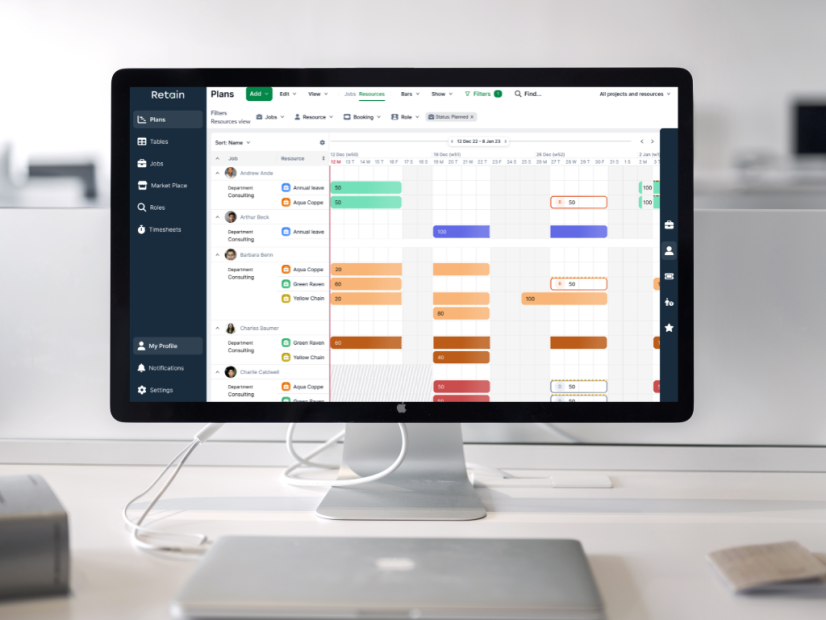In this resource planning guide, we'll walk you through the ins and outs of resource planning. We'll show you how it can boost your return on investment (ROI), explore best practices, and offer some practical tips to help you get started. We want to draw your attention to the benefits of using team resource scheduling platforms like Retain.

What is resource planning?
The basics
Let's start at the beginning – what is resource planning? Put simply, resource planning is a strategic approach that ensures all available resources, including people, skills, time, and materials, are used effectively and efficiently. ‘Resources' could be the team members working on a project, the time they have to complete tasks, or the budget allocated for a particular project.
The goal is to get the job done in the most efficient way, and with client budgets, while maintaining a high level of quality.

Resource planning in Excel
How to do it better
If you’re struggling with Excel, you’re not alone. The trouble is, Excel is your typical jack-of-all-trades—master of none. So while you might muddle along for a while, as soon as client demands and multi-user access issues creep in, it’s no longer enough.
The pitfalls of Excel for resource management:
- Limited visibility
- Manual hassle
- Inflexible planning
- Weak analytics
See how Excel compares to resource planning software ➡️

Making the switch
Moving to software
Switching from spreadsheets to software doesn’t need to feel like a significant change. Here are a few steps that can help:
- Answer the "why" first. Does Excel lack visibility, is it unmanageable as the business grows, is it siloed and disconnected from other key tools?
- Decide what you want a solution to do. Do you need to run ‘what-if’ scenarios? Optimise utilisation rates? Have a clear picture of what you want to achieve.
- Identify who will benefit from the switch. Next, you’ll need to consider who will benefit from dedicated software and the benefits they’ll see.
- Think about access needs. Resource planning software can be on-premise or there cloud-based. Not every provider will offer both options.
- Plan when to switch. To make this happen, you’ll need to set a date. Depending on who needs to be involved, you may need a timeline for this.

Case example
Boosting profitability with software
Pitcher Partners experienced rapid growth that outpaced their resource planning capabilities. By implementing Retain resource management software, they gained organisation-wide visibility into resource availability and project demands, resulting in optimised staff utilisation and increased profitability.
Show me the full case study ➡️
The benefits of resource planning software
Resource planning software offers a wide range of benefits. By using the right tech, your business gains a competitive advantage, attracts top talent, and builds a positive work environment:
Increase productivity
Resource planning software ensures that employees are well-suited to their roles and equipped with the right skills and resources, leading to increased productivity.
Reduced costs
The right tech reduces turnover, recruitment, and training costs. It also helps optimise staffing levels, preventing over or understaffing that can result in unnecessary expenses or lost revenue.
Adaptability to change
Resource planning software enables businesses to create robust measures to cope with changing customer demands, business expansion, and external factors like political and economic conditions.
Retain talent
Assign people to work they enjoy and provide the tools for a positive work environment, supporting employee retention.
Improve hiring
Attract and hire highly the right people by identifying the required skill sets for specific roles. Plus with predictive insights you can be proactive about current and future staffing needs, supporting growth and expansion.
Competitive advantage
By anticipating and addressing future needs, the right software helps you to stay ahead of the competition, attract top talent, develop innovative products and services, and respond effectively to market changes. This positions the business for long-term success.

Unlock ROI
How does resource planning software boost ROI?
With real-time data and insights, teams can work better together, make better decisions, and enhance efficiency:
- Improved efficiency: Optimises processes with complete visibility for better planning, forecasting, and inventory management, leading to streamlined workflows, reduced bottlenecks, and enhanced resource allocation.
- Accurate job costings: Accurate job costing helps assess profitability, suggest accurate pricing, and identify areas for cost optimisation, leading to improved financial performance.
- Better cash flow: With insights into accounts receivable, accounts payable, and cash flow, businesses can make informed decisions about expenses, investments, and revenue generation, supporting overall growth.
Read more about ROI in resource planning here or with use our ROI calculator.➡️

Looking ahead
Future proofing resource planning
Resource planning plays a critical role in addressing today’s resource challenges and helping you to be proactive for the future:
- Replacing outdated tools: Outdated tools lack visibility and control over your resource pool, making it difficult to assess utilisation rates, profitability, and match people to the right projects. Plus, they fall short in meeting the growing needs and pressures of the industry.
- Planning for the future: But a modern, scalable approach to resource planning will address today and tomorrow's disruptive changes. By leveraging advanced AI and ML capabilities, firms can automate resource allocation, identify available capacity, and assign matters efficiently.
You can read more about future-proofing resource planning here ➡️

Get ahead with Retain
Revolutionise resource planning
If you’re looking to boost resource planning, give Retain a try. Retain keeps everything in one place for simple, speedy scheduling, rapid resource planning, and the ability to pinpoint the right people with AI-powered skills matching.
Plus AI models continuously learn over time. This means you're not just managing resources better today—each day it's becoming increasingly effective for you. To learn how Retain can help simplify and solve your resource planning, get a demo today.
Frequently Asked Questions
Resource planning is the process of forecasting and allocating an organisation's resources over a certain period to accomplish goals and objectives. It involves assessing resource needs, availability, and capacity to create an optimal plan for assigning resources to projects and tasks. An effective resource planning strategy maximises utilisation and productivity.
Resource planning software is designed to optimise and automate resource planning across an organisation. It provides an easy-to-use centralised database to manage resource profiles, skills, budgets, and much more. Key features include demand forecasting, capacity planning, scheduling, utilisation tracking, and analytics. Resource planning software gives real-time visibility into resource allocation and availability. This enables better planning decisions to maximise productivity and utilisation, and enhances human resource management.
Effective resource management involves several key steps:
- Assess upcoming resource needs based on goals, projects, and forecasts
- Take stock of available project resources and their skills/capabilities, plus any project requirements for each entire project
- Compare needs to availability to identify gaps and project tasks
- Develop options to address gaps, like hiring, training, or contingency plans
- Create an optimised schedule that aligns resources with specific tasks and timeframes and ensures you manage projects on time
- Continuously monitor utilisation and adjust plans as needs change for future projects and your changing resource schedule
Using a resource planning tool like Retain streamlines these steps. Retain centralises resource and project data, enables scenario planning, prevents resource constraints, provides real-time visibility into utilisation, and automates scheduling based on availability and skills. This makes resource planning easier, more efficient, and more accurate and helps you develop a robust resource management plan.
When it comes to the basics of resource planning, it's about getting the job done in the most efficient way, in line with client budgets, while maintaining a high level of quality. We like to think about it in a few simple steps:
- Gather your resource planning requirements (client requirements, budget, timescales, etc)
- Check resource skills and availability
- Match projects to the right people (based on skills, capacity, and more)
- Track time (this helps if you do it in the same place as your resource scheduling)
- Monitor projects and employees (and course correct as you go)
- Report to stakeholders on project success
Of course, this is all made much easier with the right tool!
A resource planner (or project manager) typically identifies, allocates, schedules, and forecasts resources for projects. Resource planners will factor in key elements like current resource utilisation rates, absences, employee skills, market fluctuations, client requirements, and more.
You may also like
- Resource Planning
- 10 min
Why and how should you improve resource scheduling
In this guide, we’ll explore both the WHY and the HOW of improving resource scheduling. So you can assess whether your organisation needs to take a leap forward, fast.
- Resource Planning
- 6 min
Understanding AI in resource management
While resource management has undergone a transformation over the years, what happens when we introduce a game-changer like AI into the mix? That’s precisely what we’ll explore in this post.
- Future of Work
- 9 min
Retain's journey in transforming resource management
Retain’s decades-long journey mirrors the evolution of resource management itself. So, to help you (and your organisation) understand more, we’ve put together this guide—including insight from our leaders.
